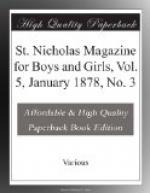And while the poet is telling you of these singers of the air, read “The Return of The Birds,” written in the early spring of 1864, when, as you know, the country was in great trouble, and the birds saw many a sorry sight. If you like a beautiful fairy-tale in verse, all about children and the elves or sprites that children love, read his “Little People of The Snow.” There also is the pretty legend of “The White-footed Deer”; or if you bigger boys and girls wish something more weird and exciting, read his tragic story of “The Strange Lady.” Then, on some lovely autumn day, when “the melancholy days are come,” and the procession of flowers has nearly passed by, read his verses “To the Fringed Gentian.” There are other poems in the collection quite as easy to understand as these. Some of the most admired indeed, that would seem “hard” to many a tall youngster at the head of the school-class, were written in the poet’s own boyhood. His most famous poem, “Thanatopsis,” was composed when he was but eighteen years of age. When you, too, are eighteen you will more than enjoy it, if you do not do so already. But you will like a song of his youth,—lines “To a Waterfowl,”—and the beautiful poem entitled “June,” which has been very much quoted of late because of the fulfillment of his wish that when he should come to lie at rest within the ground, he might be laid there
“in
flowery June,
When brooks send up a cheerful
tune,
And groves a joyous
sound.”
Another beautiful poem, called “Waiting by the Gate,” will be quite clear to many of you; and one and all can understand “An Invitation to the Country,” addressed to Julia, the poet’s devoted daughter, the joy of his old age, who brightened his declining years, and to the last was the faithful companion of his home.
You remember the story of his boyhood days that Mr. Bryant told you in these pages nearly two years ago? Good as that story is, there is a picture in his lovely home at Roslyn that could tell you even better things. It is the portrait of his beautiful young mother, which for years has shone upon him from the walls of his bedroom with such a strong, sweet, loving look in her face that it makes one feel sure that he was reared in a happy home, that his noble, useful manhood sprang from a sunny, well-directed boyhood. Long ago the good mother passed from earth, and now the gate through which she passed has opened for him in his serene old age, the gate of which he wrote:
“And some approach the threshold
whose looks are blank with fear,
And some whose temples brighten
with joy in drawing near,
As if they saw dear faces,
and caught the gracious eye
Of Him, the Sinless Teacher,
who came for us to die.
“I mark the joy, the terror;
yet these, within my heart,
Can neither wake the dread
nor the longing to depart;
And, in the sunshine streaming
on quiet wood and lea,
I stand and calmly wait till
the hinges turn for me.”




